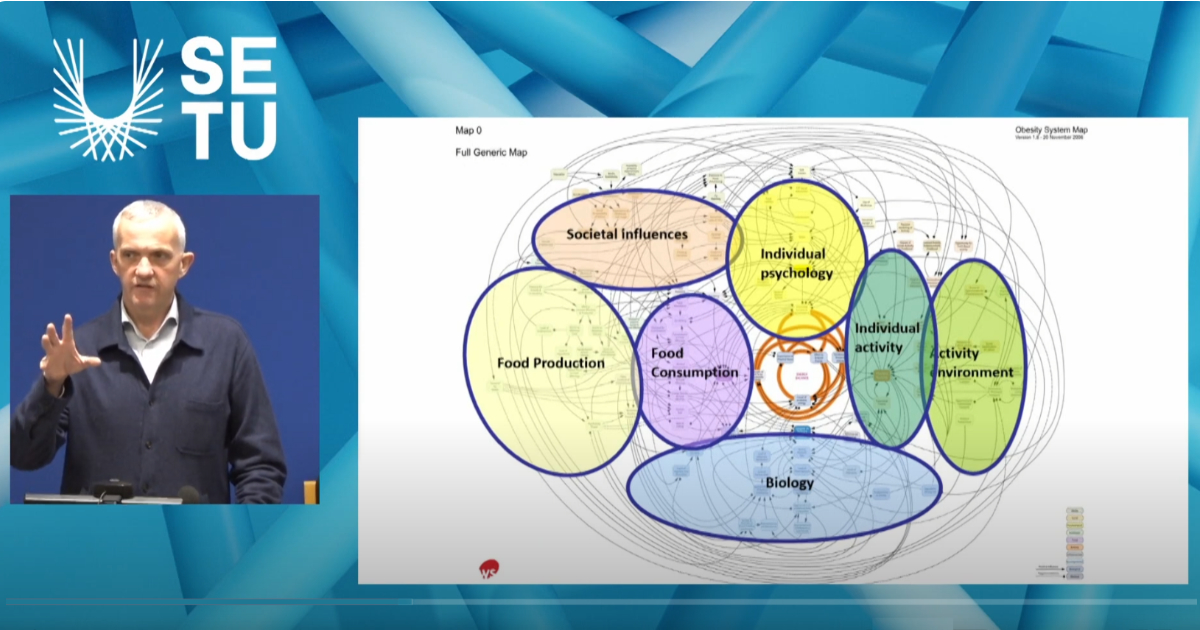Eat Less, Eat Better, Move More—for Life
In Tuesday’s Memo, Dr. Donal O’Shea suggested that there’s compelling evidence that eating less and moving more won’t result in permanent weight loss because the set point theory is just too strong and will defeat the effort of 90% of the people. However, he didn’t provide any evidence that’s true. I’ll give him the benefit of the doubt, because every study done on diets shows that people do gain back some or all of the weight they lost. He attributes that to the complexity of obesity.
The Complexity of Obesity
Take a good look at the graphic used in the heading. What you can’t read are the 198 determinants (all those gray lines) that contribute to obesity. He narrows them down to just seven categories, five of which are not under the control of people once they are fat. In case it’s difficult to read, here is the list.
- Societal influences
- Food production
- Activity environment
- Biology
- Individual psychology
- Food consumption
- Individual activity
He also gives a compelling argument that the immune system, working in conjunction with fat cells, causes inflammation in a variety of ways which prevents people from losing weight.
The problem that I have is two-fold. First, it seems the last three are under the control of the individual: eating, moving, and deciding to do so. The exterior forces are what they are, but biology can change. Aging is the perfect example of that.
As for immunity, here’s the real question about the immune system: is it cause or effect? The increase in inflammation is remarkably similar to the increase in cortisol found in people who are obese. Is it the cause of obesity or is it the result of being obese? It makes a difference.
Why Medication Won’t Be the Permanent Solution
Before I get into this, I think that medications may play a role in the solution for some, maybe even most severely overweight people. But they will not be a permanent solution, and the reason may be found in the proteome. You may remember that those are the proteins coded for in our DNA; they range from hormones such as insulin to catalysts for other chemical reactions. There are about 5,000 proteins that are the most researched, but with about 20,000 genes, there may be at least 15,000 more genes that are not researched. That doesn’t count the post-translational modifications, modifications made to the protein as it’s being made; the total could get into the millions.
It’s unrealistic to think that a combination of three, five, or even ten receptor agonists will solve obesity and not cause issues elsewhere in the body by interfering with the production of other necessary proteins. I’m not suggesting that temporary use to get the bulk of weight off an individual won’t be a good way to start, but it’s not a permanent solution as I see it, even if you can afford to take it the rest of your life.
The Bottom Line
The issue with O’Shea’s approach is that it comes from a strictly medical perspective. A nutritional solution isn’t considered and somewhere along the line, just like with gastric bypass, people will exceed their desired caloric intake and regain weight. Why? Because they haven’t learned anything.
Remember, in those seven categories he cited, food consumption and activity levels are under the control of the individual. That means both the quantity and the type of food as well as the amount of activity are under the control of the individual. I’ll say it again: it was, it is, and it will always be about the calories—how much you take in versus how much you use. Take in more than you use, and you gain weight. It’s that simple.
Obesity is complex because our bodies are complicated, but this is still my recommendation: eat better, eat less, and move more. If I were to add two more words that I’ve implied but haven’t stated, they would be “for life” because the only way to hold on to your progress is to keep working on your lifestyle.
What are you prepared to do today?
Dr. Chet
References:
1. SETU. Understanding Obesity: Rethinking Diagnosis & Treatment. 2024.
2. Nat Chem Biol. 2018 Feb 14; 14(3): 206–214.









